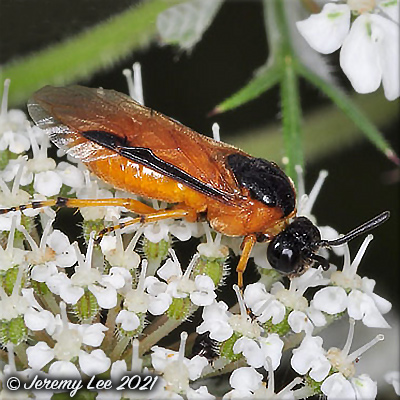
 |
|
Scientific Classifications explained » Amphibians » Ants » Aphids » Bees » Beetles » Birds » Bugs » Butterflies » Caterpillars » Damselflies » Dragonflies » Earwigs » Flies » Frog/Leafhoppers » Fungi » Galls » Grasshoppers » Harvestmen » Hoverflies » Lacewings » Ladybirds » Leaf Mines » Lichens » Mammals » Millipedes » Mosses » Moths » Sawflies » Slugs » Snails » Spiders » Trees & Shrubs » Wasps » Wild Flowers » Woodlice » Postboxes |
UK Nature > Sawflies > Arge ochropus

Scientific Name: Arge ochropus Common Name: Large Rose Sawfly In Britain there are two species of large rose sawfly: Arge ochropus (pictured above) and Arge pagana. The adult insects of both species have yellow abdomens; A. ochropus has legs and thorax mostly orange-yellow, the legs having black rings towards the feet. A. pagana is the more common species and has a completely black thorax and legs. Rows of eggs are inserted into soft young rose shoots and female sawflies are sometimes seen dangling from such stems, attached only by their saw-like egg-laying organs. After hatching, the larvae feed together in family groups. They are pale green with black spots and yellow blotches, and are up to 25mm (about 1in) long. A. pagana will produce two (sometimes three) generations from May to October whereas A. ochropus usually has a single generation in early summer, but sometimes there is a second generation in late summer. |
|

https://www.uknature.co.uk is a website dedicated to showing the immense diversity of UK nature and wildlife. Our vast range of habitats, from lowland arable to snow covered mountains, from storm-ravaged coastlines to peaceful inland freshwater lakes and rivers, from dry, sandy heaths to deciduous and coniferous forests, all these habitats contribute to the abundance of UK nature. We have wild birds in huge numbers either residing or visiting our shores (597 recorded species as at July 2013) and we must also not forget the humble back garden with its grass lawns, flower beds filled with nectar rich flowers, shrubs and trees, all designed to attract huge numbers of insects such as bees, moths, butterflies and hoverflies; and finally the small ponds which provide safe havens for frogs, toads, newts and even slow worms and grass snakes. www.uknature.co.uk is the showcase for my personal passion, photographing uknature in all its glory. I sincerely hope you all enjoy the fruits of my labours. This site and all images contained therein is © Jeremy Lee 2004 - 2025. All Rights Reserved. Site design by Jeremy Lee. Site development & IT Support by Stuart Lee. |